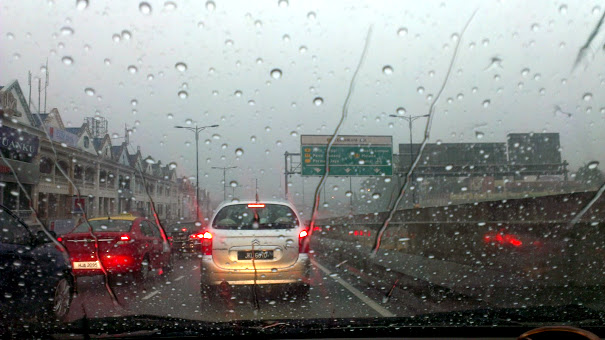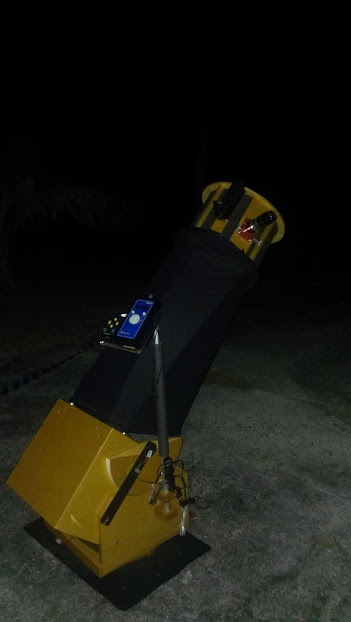
But first, a sumptous dinner in JB to take advantage of the cheaper Ringgit
(Note: Dish with green flag was Gary's, not mine! Reverse side of the toothpick-flag says "Not So Brave!"

On to Sedili and thankfully by then the skies had cleared to intermittent passing clouds. A nightmare for imagers but no issue for visual observers! Sadly, Servocat chose this time to malfunction so for the night we were forced to put the scope through its paces manually. This turned out to be a good thing because it gave me increased confidence in my scope and its manual use. Besides, I had the guru of visuals, Gary, present to be my goto unit!
After a quick setup and collimation (its really much faster than setting up any tripod based mount!), we were good to go and Pleiades was the first target! Using a 31mm eyepiece we were only able to get part of the large cluster in view but Gary could see some faint nebulosity surrounds the main stars. On my part I though it might be background haze or glare from the stars but I'm not sure.
Then on to Jupiter! The king of the planets. Jupiter is a very discriminating target because it has both high and low contrast features. In a telescope, optical quality is often determined by the contrast produced by the telescope, much less so than the sheer brightness afforded by the aperture. It was a lovely sight at 51x in the 31mm but on switching to an 8mm eyepiece at 200x, the detail was breathtaking! I was too busy admiring the swirls in the Great Red Spot and the 3 white ovals nearby to count the bands. All this when Jupiter was already setting hence in less optimal observing position was truly impressive!
However, we didn't drive all the way there just to look at planets! Planets can be seen just as well from Singapore. On to that famous Great Nebula in Orion. The Orion Nebula is easily visible back in bright Singapore through 50mm binos and even the naked eye on good nights although its more often seen as a patch of brightness in the approximate fan or bat shape. Through the 31mm the detail seen in the cloud was truly breathtaking. To call it "nebulosity" simply does not convey the depth of detail visible. The 2 main arms were visible as thick tubes extending outward where they fan out and eventually join (yes, the WHOLE nebula was visible, including the much dimmer outer areas, to direct vision) The centre where the Trapezium lies almost looked like it was in a bowl formed by the 2 arms, with much ripples or waves easily seen. At this power one can only make out 4 trapezium stars. Faced with this display, we didn't bother with the UHC filter. To see if we could split the Trapezium, we changed back to the 8mm giving 200x. Now the E and F stars of the trapezium were clearly visible to casual direct observation. No need for squinting, concentrating or averted vision. The texture of the nebula through the view was truly awesome. I felt as if I was in a spacecraft looking up into the vast stellar cloud!
Encouraged to move on (ahem!), we cycled through a variety of open clusters. Here the 14" did not perform as amazingly as it did previously, mainly because in a dark sky a fair amount of open clusters are well visualized in smaller telescopes and large enough that the True Field of View (TFOV) of my widest eyepiece (1.8°) did not frame the cluster fully in its surroundings. Here I actually preferred, for some, the view through a 4" refractor. Of course we were only looking at Messier catalogued clusters, which are among the brightest in the sky. If we had turned the scope to much dimmer clusters then the much smaller aperture of the 4" would have been woefully inadequate. Among the open clusters though, one special one deserves mention: M35 in Gemini is a beautiful cluster spanning about 2/3 of a degree but when lookign at it in the big scope, there was a wisp of "nebulosity" at one side, almost as if God took a cotton ball to clean the cluster then left it there! In closer inspection the "nebulosity" appeared granular so again in went the 8mm eyepiece which afforded a well resolved view of the globular cluster NGC2168. It was a beautiful sight of shimmering points on a dark sky with the adjacent bright stars of the cluster. I most appreciated this view most in the 13mm which, at 0.8deg TFOV gave the best balance between field of view and power to resolve NGC2168
We then moved on to galaxy hunting! Traditionally the forte of larger scopes, the 14" put in a good performance. All 3 of the Leo triplets were clearly and evidently visible to casual direct vision. The dark band across NGC3628 was visible to me with direct vision when concentrating on it. It was, however easily noticed in averted vision. Moving on to the Whirlpool in Canes Venaticti (or more easily, just at the end of the handle in the Big Dipper), the dual cores with surrounding brightness was seen. Very nice! Unfortunately our skies were (for a dark site) moderately bright due to some new chalets with naked bright bulbs built just adjacent to the observation area as well as the high moisture in the sky from the recently passed rainstorm so some of the outer features of the galaxies simply blended into the not-quite-black skies.
By this time the Eta Carina area had risen into view. Here lots of open clusters come into view, including the very large Southern Pleiades and X Car cluster (NGC3532). Again I much preferred the larger FOV of the refractor although this region is so star rich that the smaller FOV of the 14" didn't seem so important. Still, at 1.6° wide, even the 31mm could not well frame the Southern Pleiades. Much better framed were the Jewel Box cluster and NGC3532. Gary saw lots of beautiful color in the Jewel Box.
On to the true gem of Carina, the Eta Carina Nebula (NGC3372)! At first glance it was somewhat disappointing: A bright streak of light like a brush stroke splashed out amongst a tapestry of glittering diamonds. this confused me for a while as I have seen the Eta C nebula through Binos and my trusty 4" refractor and one can make out its flower-shape, vaguely, with that bright streak being the brightest petal. Thoughts flashed through my mind: How large scopes don't really brighten extended objects, such as nebulae: they just magnify them. Truthfully, I was quite disappointed at this time. Why nothing more than a splash of light? After the awe inspiring spectacle that was the Orion nebula! Checking back with Skysafari, I noticed one small detail: The whole Eta Carina Nebula spanned more than 2 degrees across! Now it dawned on me: I wasn't seeing more nebulosity because the entire eyepiece was ALL nebula! Unfortunately our skies were not so dark that the dark lanes between the lobes of the nebula were evident. In goes the UHC filter and suddenly I'm staring down the dark lanes separating the lobes of the nebula. Texture and filaments of dark dust lanes interspersed by the all-pervading glow of nebula light filled the whole eyepiece making this again an wonderful spectacle. through my silly grin I unfortunately forgot to hunt out the Homunculus, that mass of ejecta from the last brightening of the Eta Carina star itself. Its mind boggling to think that about 10 years after Singapore was founded by Sir Stamford Raffles, Eta Carina was the second brightest star in the sky, losing only to Sirius! How our ancestors must have gazed at that "new" star in the darkness that was then the Kampung of Singapura, the port-island south of Malaya.
On to Omega Centauri, that pre-eminent of Globulars. To say jaw-dropping was an understatement as the cluster was fully resolved down to its core. previously I've never paid much attention to observing Omega C because its often just a hazy blob with some surrounding granularity in both my 4" refractor and 8" MCT. With the 14" though it was a large ball of twinkling diamonds with almost no core and I could almost imagine irregular, twisty dark lanes coursing through the near-centre, like secret extra-galactic country lanes going down tree-filled hollows. Gary best enjoyed the view at 76x in the 21mm although I found that to still be too small for my liking. I enjoyed it best in the 8" where it filled up two-thirds of the FOV. I could just stare at it for hours...
By now it was getting late and what with family commitments, Gary was reminding me its time to pack up (Thanks Gary for helping me ensure my "higher authority" will allow future trips!) Still, a short pause to view that most mesmerizing of planets, Saturn. By now it had just risen above the treetops. While not in optimal position (Planets suffer greatly from atmospheric effects because of their small-sized features so the best position for planetary viewing is really near-zenith), through the 31mm Saturn was nicely seen as a miniature caricature of itself, with rings well defined. Pop in the 8mm and suddenly here's a much larger planet with the Cassini division in the rings clearly visible and bands on the planet itself. Sadly, the absence of Servocat made it difficult to keep the planet from drifting as I popped in the next eyepiece, a 3.7mm for 432x, but the view was again, fantastic. (I'm trying not to let my jaw drop too much. Dentists are so expensive and hard to make appointments with!) Not only was the Cassini divison a chasm diving the rings, but I could easily see the "texture" in the rings, thickest just inside of Cassini and thinner on the inner and outer rims of the rings. I think I could faintly see the Encke Divison as well. The globe of the planet was a series of grey-yellow bands in upper hemisphere and golden-yellow in the lower that was not covered by the rings.
After a brief period more of admiring the planet together, Gary, ever mindful of my welfare reminded me of the time again and reluctantly we packed up and headed home.
Me looking fat and looking into the eyepiece at the same time

The scope

![good-job [smilie=good-job.gif]](./images/smilies/good-job.gif)

![admire [smilie=admire.gif]](./images/smilies/admire.gif)